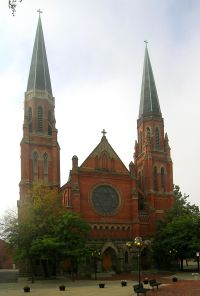History of Detroit
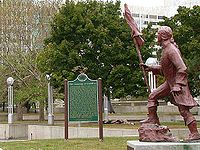
The city of Detroit, Michigan developed from a French fort and missionary outpost founded in 1701 to one of the largest American cities in the early 20th century. Based on its auto industry, Detroit's economy expanded following World War II with a post war economic prosperity. A population shift to the suburbs began in the 1950s and continued as the metropolitan area grew to one of the nation's largest. The city experienced social tensions during the 1960s and 1970s. In the 1990s and first decade of the 21st century, the city has experienced increased urban renewal. Many areas of the city are listed in the National Register of Historic Places.
Detroit, settled in 1701, is one of the oldest cities in the Midwest. Detroit experienced a disastrous fire in 1805 which nearly destroyed the city, leaving little present-day evidence of 17th and 18th Century Detroit save streets named for early French settlers, their surviving French ancestors, and what remains of the twelve original missionary pear trees.[3] After the fire, Judge Augustus B. Woodward designed a plan of evenly spaced public parks with interconnecting semi-circular and diagonal streets. Although Woodward's plan was not fully implemented, the basic outline in still in place today in the heart of the city. Main thoroughfares radiate outward from the center of the city like spokes in a wheel, with Jefferson Avenue running parallel to the river, Woodward Avenue running perpendicular to it, and Gratiot, Michigan, and Grand River Avenues interspersed. A sixth main street, Fort, wanders downriver from the center of the city.
Contents |
17th century
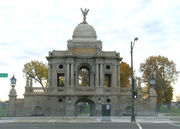
The first recorded mention of what became Detroit was in 1670, when the French Sulpician missionaries François Dollier de Casson and René Bréhant de Galinée stopped at the site on their way to the mission at Sault Ste. Marie.[4] Galínee's journal notes that near the site of present-day Detroit, they found a stone idol venerated by the Indians and destroyed the idol with an axe and dropped the pieces into the river. Early French settlers planted twelve missionary pear trees "named for the twelve Apostles" on the grounds of what is now Waterworks Park.[3]
18th century
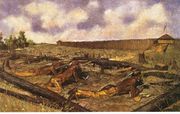

The city name comes from the Detroit River (French: le détroit du Lac Érie), meaning the strait of Lake Erie, linking Lake Huron and Lake Erie; in the historical context, the strait included Lake St. Clair and the St. Clair River.[5] Traveling up the Detroit River on the ship Le Griffon (owned by La Salle), Father Louis Hennepin noted the north bank of the river as an ideal location for a settlement. There, in 1701, the French officer Antoine de la Mothe Cadillac, along with fifty-one additional French-Canadians, founded a settlement called Fort Ponchartrain du Détroit, naming it after the comte de Pontchartrain, Minister of Marine under Louis XIV. Ste. Anne de Détroit, founded July 26, 1701, is the second oldest continuously operating Roman Catholic parish in the United States and the church was the first building erected at Fort Ponchartrain du Détroit.[1][2][6][7] France offered free land to attract families to Detroit, which grew to 800 people in 1765, the largest city between Montreal and New Orleans.[8] Francois Marie Picoté, sieur de Belestre (Montreal 1719–1793) was the last French military commander at Fort Detroit (1758–1760), surrendering the fort on November 29, 1760 to British Major Robert Rogers (of Rogers' Rangers fame and sponsor of the Jonathan Carver expedition to St. Anthony Falls). The British gained control of the area in 1760 and were thwarted by an Indian attack three years later during Pontiac's Rebellion. The region's fur trade was an important economic activity. Detroit's city flag reflects this French heritage. (See Flag of Detroit).[1]
.jpg)
During the French and Indian War (1760), British troops gained control and shortened the name to Detroit. Several tribes led by Chief Pontiac, an Ottawa leader, launched Pontiac's Rebellion (1763), including a siege of Fort Detroit. Partially in response to this, the British Royal Proclamation of 1763 included restrictions on white settlement in unceded Indian territories. Detroit passed to the United States under the Jay Treaty (1796). In 1805, fire destroyed most of the settlement. A river warehouse and brick chimneys of the wooden homes were the sole structures to survive.[9]
Father Gabriel Richard arrived at Ste. Anne's in 1796. While the local priest, he helped start the school which evolved into the University of Michigan, started primary schools for white boys and girls as well as for Indians, as a territorial representative to U.S. Congress helped establish a road-building project that connected Detroit and Chicago, and brought the first printing press to Michigan which printed the first Michigan newspaper. After his death in 1832, Richard was interred under the altar of Ste. Anne's.[1][2]
Detroit was the goal of various American campaigns during the American Revolution, but logistical difficulties in the North American frontier and American Indian allies of Great Britain would keep any armed rebel force from reaching the Detroit area. In the Treaty of Paris (1783), Great Britain ceded territory that included Detroit to the newly recognized United States, though in reality it remained under British control. Great Britain continued to trade with and defend her native allies in the area, and supplied local nations with weapons to harass American settlers and soldiers.
In 1794, a Native American alliance, that had received some support and encouragement from the British, was decisively defeated by General Anthony Wayne at the Battle of Fallen Timbers. Wayne negotiated the Treaty of Greenville (1795) with many of these nations, in which tribes ceded the area of Fort Detroit to the United States. Detroit passed to the United States under the Jay Treaty (1796). Great Britain agreed to evacuate forts held in the United States' Northwest Territory. In 1805, a fire destroyed most of the settlement. A river warehouse and brick chimneys of the wooden homes were the sole remains of the structures.[9] Detroit's motto and seal (as on the Flag) reflect this fire.
19th century
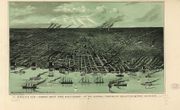
First incorporation
Detroit was incorporated as a town by the legislature of the Northwest Territory at Chillicothe, Ohio, on January 18, 1802, effective February 1, 1802. Government was administered by a five-person board of trustees and there was no office of mayor. Following this, Ohio became a state and the eastern half of Michigan was attached to the Indiana Territory.
1805 fire
Before the new territorial government officially began, a fire destroyed nearly all of Detroit on June 11, 1805. Because of the difficulty in traveling from Detroit to the capital of the territory in Vincennes over 400 miles (640 km) away, Michigan Territory was established effective June 30, 1805, as a separate territory with Detroit as the capital. The newly appointed governor, William Hull, and the territorial judges (Augustus B. Woodward, Frederick Bates, James Witherell, and John Griffin), constituting the territorial government, essentially established martial law over affairs of the city. They convinced the U.S. Congress to pass an act on April 21, 1806, which authorized them to lay out a town that included all of the old town of Detroit plus an additional 10,000 acres (40 km²) to be used as compensation for persons who lost their house in the fire.[10]

City incorporation
On September 13, 1806, the territorial government passed an act incorporating the new city of Detroit. The governor appointed Solomon Sibley as mayor. Shortly afterward, Sibley resigned and Elijah Brush was appointed in his stead. The mayor was appointed by the governor and, under the act of incorporation, was able to disapprove legislation passed by the popularly elected council without any recourse for overriding the mayor. Because of this, many felt that the real aim of the governor in incorporating the city was to remove the popularly elected town officers and exert a more direct influence over governance of the city.[11] This form of government was extremely unpopular, and was repealed on February 4, 1809. However, to prevent resurrection of the popularly elected town government, on September 16, 1810, an act passed repealing all laws pertaining to Michigan that had been passed by the Legislature of the Northwest Territory. This effectively eradicated any trace of legitimacy for the former popularly elected town government.
War of 1812
This state of affairs continued through the War of 1812, during which Governor Hull surrendered Detroit to the British. Lewis Cass, who replaced Hull as territorial governor, on October 24, 1815, restored control of local affairs to the people of Detroit, with the election of a five-person board of trustees and enactment of a charter for the city of Detroit.
Creation of common council
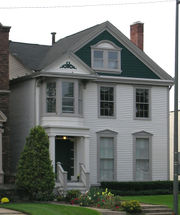
Government under the board of trustees continued until an act of the Territorial Legislature on August 5, 1824, created a Common Council of the City of Detroit. The Council consisted of five aldermen, the mayor, and the recorder. In an act of April 4, 1827, the number of aldermen increased to seven. In 1839, it increased to 14: two aldermen from six wards plus the mayor and recorder. A seventh ward was created in 1848, an eighth in 1849, and the ninth and tenth wards in 1857. Also in 1857, a new city charter provided that the mayor and recorder would no longer sit as members of the council. At this time, the council consisted of 20 members, two aldermen from ten wards. In 1873, a twelfth ward was added and aldermen from an illegally constituted eleventh ward also temporarily sat on the council. In 1875, a properly constituted eleventh ward and a thirteenth ward were added. The city charter of 1883 changed the name of the body to the Board of Aldermen. A few years earlier in 1881, a separately elected ten-person body named Board of Councilmen (also called the City Council), was established. This body was abolished in 1887.
After Detroit rebuilt in the early 19th century, a thriving community soon sprang up, and by the Civil War, over 45,000 people were living in the city,[12] primarily spread along Jefferson Avenue to the east and Fort Street to the west. As in many major American cities, subsequent redevelopment of the central city through the next 150 years has eliminated all but a handful of the antebellum structures in Detroit. The oldest remaining structures are those built as private residences, including a group in the Corktown neighborhood and another set of houses strung along Jefferson Avenue — notably the Charles Trowbridge House (1826), the oldest known structure in the city), the Joseph Campau House (1835), the Sibley House (1848), the Beaubien House (1851), and the Moross House (1855). Other extant pre-1860 structures include Fort Wayne (1849); Saints Peter and Paul Church (1848) and Mariner's Church (1849); and scattered commercial buildings (one in Randolph Street Commercial Buildings Historic District, for example).
American Civil War era
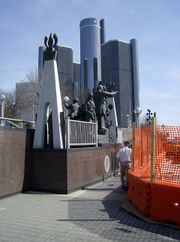
Prior to the American Civil War, the city's access to the Canadian border made it a key stop along the underground railroad.[13] The Michigan Soldiers' and Sailors' Monument in Detroit's Campus Martius Park commentorates the state's role in the American Civil War. Then a Lieutenant, the future president Ulysses S. Grant was stationed in the city. His dwelling is still at the Michigan State Fairgrounds. Because of this local sentiment, many Detroiters volunteered to fight during the American Civil War, including the 24th Michigan Infantry Regiment (part of the legendary Iron Brigade) which fought with distinction and suffered 82% casualties at Gettysburg in 1863. Abraham Lincoln is quoted as saying Thank God for Michigan! Following the death of President Abraham Lincoln, George Armstrong Custer delivered a eulogy to the thousands gathered near Campus Martius Park. Custer led the Michigan Brigade during the American Civil War and called them the Wolverines.[14]
The Detroit Race Riot (1863) occurred on March 6, 1863 and was the city's first such incident. At the time, it was reported as "the bloodiest day that ever dawned upon Detroit."[15][16] The casualties of the day included at least two people dead, a multitude of others injured, mostly African-American, 35 buildings were burned to the ground, and a number of other buildings were damaged by fire.[16]
Rise of industry and commerce
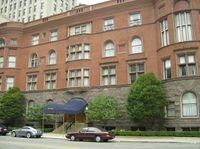
As Detroit grew into a thriving hub of commerce and industry, the city spread along Jefferson, with multiple manufacturing firms taking advantage of the transportation resources afforded by the river and a parallel rail line. Parke-Davis, for example, established a center between East Jefferson Avenue the river in the 1870s; another pharmeceutical firm, the Frederick Stearns Company, built a plant in the same area in the 1890s. Globe Tobacco built a manufacturing facility closer to downtown in 1888.
The rise of manufacturing led to a new class of wealthy industrialists, entrepreneurs, and professionals. Some of these nouveau riche built along East Jefferson, resulting in structures such as the Thomas A. Parker House (1868), the Croul-Palms House (1881), the William H. Wells House (1889), the John N. Bagley House (1889), and the Frederick K. Stearns House (1902).
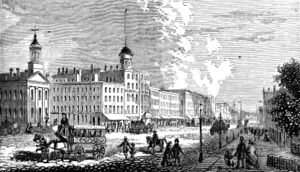
Detroit began increasingly to expand, and other citizens pushed north of downtown, building houses along Woodward in what was at the time a quiet residential area. The city has many restored historic Victorian structures, notably those in the Brush Park and East Ferry Avenue historic districts. The Elisha Taylor House (1870) and the Hudson-Evans House (1872) are both in Brush Park; the Col. Frank J. Hecker House (1888) and the Charles Lang Freer House (1887) are in the East Ferry Avenue neighbhorhood. Near the end of the century, apartment living became more acceptable for affluent middle-class families, and upscale apartments, such as the Coronado Apartments (1894), the Verona Apartments (1894), the Palms Apartments (1903), the Davenport Apartments (1905) in the Cass-Davenport Historic District, and the Garden Court Apartments (1915) were constructed to meet the new demand.
These well-to-do late-19th-century residents also funded the construction of a spate of churches, such as the Cass Avenue Methodist Episcopal Church (1883), the First Presbyterian Church (1889), the Trinity Episcopal Church (1890) (built by James E. Scripps), and the First Unitarian Church (1890).
Immigrants
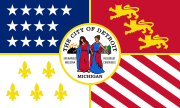
Detroit has long been a city of immigrants, from the early French and English settlers in the 18th century, through the Irish who settled in the Corktown neighborhood in the 1840s, to the Greeks, who settled in the Greektown neighborhood in the early 20th century and the southern whites and African-Americans who came to Detroit in the years before the Great Depression. Detroit's industrial boom in the later 19th century created yet another stream of immigrants into Detroit. Perhaps the most significant contingents during this period were the German and Polish immigrants who settled in Detroit in the 1860-1890s. This was followed by a wave of Italian immigrants in the late 19th and early 20th centuries.[17]
Germans came first, establishing German-speaking churches, primarily on the east side of the city, including Saint John's-St. Luke's Evangelical Church (1872), St. Joseph Catholic Church (1873), and Sacred Heart Roman Catholic Church (1875), as well as social clubs such as the Harmonie Club (1894) and west-side churches such as St. Boniface (1882) and Gethsemane Evangelical Lutheran Church (1891).
Close behind, a wave of Polish immigrants established east-side Roman Catholic parishes such as St. Albertus (1885), Sweetest Heart Of Mary (1893), St. Josaphat's (1901), St. Stanislaus (1911), and St. Thomas the Apostle Catholic Church (1923). The Poles also settled on the west side, founding West Side Dom Polski (1916). The son of Prussian Polish immigrants, Rev. John A. Lemke, born in Detroit on February 10, 1866, was the first American-born Roman Catholic Priest of Polish descent to be ordained in America.[18] He was Baptised at St. Mary Roman Catholic Church (1843), at the corner of St. Antoine and Croghan (Monroe), on February 18, 1866, attended St. Albertus for his primary education, and studied at Detroit College which is now the University of Detroit Mercy where he received a Bachelor's degree in 1884; then, after attending St. Mary's in Baltimore, he completed his theological studies at St. Francis Seminary in Monroe, Michigan, and he was ordained by the Bishop John Samuel Foley in 1889.[18] His added confirmation name was Aloysius.[18]
20th century

Henry Ford and the automobile industry
A thriving carriage trade set the stage for the work of Henry Ford, who in 1899 built his first automobile factory in Highland Park, an independent city that is now surrounded by Detroit. Ford's manufacturing innovations were soon adopted by rival automobile manufacturers, including General Motors, Chrysler and American Motors. Each of them, like Ford, established its headquarters in the Detroit metropolitan area, solidifying Detroit's status as the world's car capital.
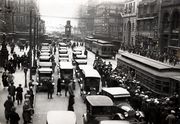
At the turn of the 20th century, entrepreneurs in the Detroit area—notably Henry Ford--forged into production of the automobile, capitalizing on the already-existing machine tool and coach-building industry in the city. Early automotive production is recognizable by structures such as Ford's Piquette Plant (1904) (a National Historic Landmark), and multiple structures in the surrounding Piquette Avenue Industrial Historic District (including the now-destroyed E-M-F/Studebaker Plant, 1906) and the New Amsterdam Historic District (including the original Cadillac factory, 1905) and small factories such as the Crescent Brass and Pin Company Building (1905).
Automobile assembly and associated manufacturing soon dominated Detroit, and the newly-minted automotive magnates built commercial and office buildings such as General Motors Building (1919), the General Motors Research Laboratory (1928), and the Fisher Building (1928).
The development of the automobile industry led to rising demands for labor, which were filled by huge numbers of newcomers from Europe and the American South. Between 1900 and 1930, the city's population soared from 265,000 to over 1.5 million, pushing the boundaries of the city outward. The population boom led to the construction of apartment buildings across the city, aimed at the middle-class auto worker. These include the Somerset Apartments (1922), the Garden Court Apartments (1915), and the Manchester Apartments (1915).
The rise of the automobile also required rethinking transportation within the city. The Chestnut Street-Grand Trunk Railroad bridge (1929) was a result of a grade separation that unsnarled train and automobile traffic. The Fort Street-Pleasant Street and Norfolk & Western Railroad Viaduct (1928) was a product of the same program, routing trucking traffic over the train traffic. And the West Jefferson Avenue-Rouge River Bridge (1922) allowed the Rouge River to be expanded for barge traffic.
Gilded Age
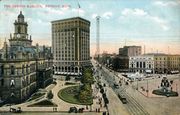
During the late 19th and early 20th centuries, many of the city's Gilded Age mansions and buildings arose. Detroit was referred to as the Paris of the West for its architecture, and for Washington Boulevard, recently electrified by Thomas Edison.[1] Besides Brush Park, more upscale neighborhoods sprang-up, including Boston-Edison, Indian Village, and Palmer Woods. Woodward Avenue neighborhoods (such as the Warren-Prentis Historic District and the Willis-Selden Historic District) became mixed with apartments and commercial buildings. Many architecturally and historically significant churches and cathedrals arose during the Gilded Age throughout the city's neighborhoods.
Automobile wealth led to a boom in downtown Detroit business, and the construction of a collection of early 20th century skyscrapers. The most notable of these is the Art Deco National Historic Landmark Guardian Building (1928). The building boom was not confined to businesses. Shopping districts sprang up along Park Avenue, Broadway, and Woodward. Multiple hotels were constructed, including the Fort Shelby Hotel (1916), the Detroit-Leland Hotel (1927), the Royal Palm Hotel (1924), and many others. Extravagant movie theaters such as the Fox (1928) and the Palms (1925) were constructed. And public buildings, such as Orchestra Hall (1919), the Detroit Public Library (1921), and the Detroit Institute of Arts (1923). As a major port, the city's riverfront received many ships. At the turn of the 20th century, the city became known as the "Paris of the West" for its architecture.[1] At the same time, Detroit's downtown flourished architecturally, under leadersship of many renowned architects including Albert Kahn, Wirt C. Rowland, and others, who designed a number of Art Deco skyscrapers and landmarks. The city experienced a cultural flowering, with a major expansion of the Detroit Institute of Arts and the founding of other institutions.[1]
Population increase
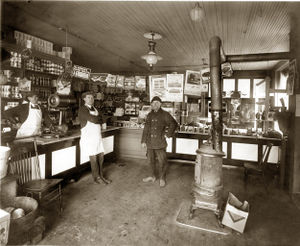
The development of the automobile industry led to a massive increase in industrial production in the city. This in turn led to rising demands for labor, which were filled by huge numbers of newcomers from Europe and the American South. The city's population increased more than sixfold during the first half of the 20th century, fed largely by an influx of European immigrants and Southern migrants to work in the burgeoning automobile industry.[19] Large numbers of immigrants from Europe settled in Detroit; Poles were a large group, by 1930 more than 66,000 Poles lived in Detroit.[20] Between 1900 and 1930, the city's population increased from 265,000 to over 1.5 million.
Labor disputes
With the factories came high-profile labor strife, climaxing in the 1930s as the United Auto Workers initiated bitter battles with Detroit's auto manufacturers. The labor activism established during those years, which brought fame and notoriety to hometown union leaders such as Jimmy Hoffa and Walter Reuther, remains a key feature on the city's cultural and political landscape.
Industry spurred growth during the first half of the 20th century as the city drew tens of thousands of new residents, particularly workers from the Southern United States, to become the nation's fourth largest. At the same time, tens of thousands of European immigrants poured into the city. Social tensions rose with the rapid pace of growth. The color blind promotion policies of the auto plants resulted in racial tension that erupted into a full-scale riot in 1943.[21]
The "Arsenal of Democracy"
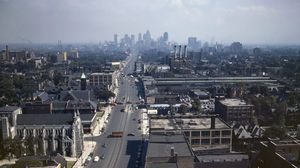
The entry of the United States into World War II brought tremendous changes to the city. From 1942 to 1945, production of commercial automobiles in the city ceased entirely, as its factories were used instead to construct M5 tanks, jeeps, and B-24 bombers for the Allies.[22] The Guardian Building was converted into a headquarters for wartime production.[22] The city's major contribution to the Allied war effort earned it the nickname "The Arsenal of Democracy."[23]
The B-24 Liberator, still the most produced allied bomber in history, helped to shift the balance of power during World War II. Prior to the war, the aviation industry could produce, optimally, one such plane a day at an aircraft plant. By 1943, Ford's plants managed to produce one B-24 an hour at a peak of 600 per month in 24 hour shifts. Many pilots slept on cots waiting for takeoff as the B-24 rolled off the assembly line at Ford's Willow Run facility.[23]
Urban issues
An extensive freeway system constructed in the 1950s and 1960s had facilitated commuting with many taking up residence in the suburbs. The Twelfth Street riot in 1967, as well as court-ordered busing accelerated white flight from the city. Commensurate with the shift of population and jobs to its suburbs, the city's tax base eroded. In the years following, Detroit's population fell from a peak of roughly 1.8 million in 1950 to about half that number today.[1]
The first black mayor, Coleman Young, was elected in 1973.[24] In the 1990s and first decade of the 21st century urban development in Detroit has led to significant revitalizations.
Recent developments
In the 1990s, the city began to experience a slow, small but steady revival, much of it centered in Downtown, Midtown, and New Center. One Detroit Center (1993) arose on the city skyline. In the ensuing years, three casinos opened in Detroit: MGM Grand Detroit, MotorCity Casino, and Greektown Casino which debuted as resorts in 2007-08. New downtown stadiums were constructed for the Detroit Tigers and Detroit Lions in 2000 and 2002, respectively; this put the Lions' home stadium in the city proper for the first time since 1974.The city also saw the historic Book Cadillac Hotel hotel and the Fort Shelby Hotel reopen for the first time in over 20 years.[25] The city hosted the 2005 MLB All-Star Game, 2006 Super Bowl XL, 2006 World Series, WrestleMania 23 in 2007 and the NCAA Final Four in April 2009 all of which prompted many improvements to the downtown area.
The city's riverfront is the focus of much development following the example of Windsor, Ontario which began its waterfront parkland conversion in the 1990s; in 2007, the first portions of the River Walk were laid, including miles of parks and fountains. This new urban development in Detroit is a mainstay in the city's plan to enhance its economy through tourism.[26] Along the river, upscale condominiums are rising, such as Watermark Detroit. Some city limit signs, particularly on the Dearborn border say "Welcome to Detroit, The Renaissance City Founded 1701".[25] [27]
In 2000, Comerica Park replaced historic Tiger Stadium as the home of the Detroit Tigers, a move that brought some controversy,[28] and in 2002 Ford Field brought football's Detroit Lions back into Detroit from suburban Pontiac.[29] The 2004 opening of the Compuware Center gave downtown Detroit its first significant new office building in a decade. Significant landmarks such as the Fox Theatre, Detroit Opera House, and the Gem Theater have been restored and host concerts, musicals, and plays. Many downtown centers such as Greektown, Cobo Center and Campus Martius Park, as well as the Michigan State Fairgrounds on the northern border, draw patrons and host activities.
The city requested an investigation in 2000 by the United States Justice Department into the Detroit Police Department which was concluded in 2003 over allegations regarding its use of force and civil rights violations.[30] The city proceeded with a major reorganization of the Detroit Police Department.
Timeline
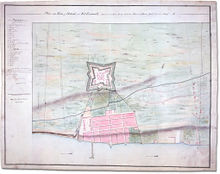
| Historical populations | ||||
|---|---|---|---|---|
| Census | City[31] | Metro[32] | Region[33] | |
| 1820 | 1,422 | N/A | N/A | |
| 1830 | 2,222 | N/A | N/A | |
| 1840 | 9,102 | N/A | N/A | |
| 1850 | 21,019 | N/A | N/A | |
| 1860 | 45,619 | N/A | N/A | |
| 1870 | 79,577 | N/A | N/A | |
| 1880 | 116,340 | N/A | N/A | |
| 1890 | 205,877 | N/A | N/A | |
| 1900 | 285,704 | 542,452 | 664,771 | |
| 1910 | 465,766 | 725,064 | 867,250 | |
| 1920 | 993,678 | 1,426,704 | 1,639,006 | |
| 1930 | 1,568,662 | 2,325,739 | 2,655,395 | |
| 1940 | 1,623,452 | 2,544,287 | 2,911,681 | |
| 1950 | 1,849,568 | 3,219,256 | 3,700,490 | |
| 1960 | 1,670,144 | 4,012,607 | 4,660,480 | |
| 1970 | 1,514,063 | 4,490,902 | 5,289,766 | |
| 1980 | 1,203,368 | 4,387,783 | 5,203,269 | |
| 1990 | 1,027,974 | 4,266,654 | 5,095,695 | |
| 2000 | 951,270 | 4,441,551 | 5,357,538 | |
| 2009* | 910,920 | 4,403,437 | 5,327,764 | |
| *Estimates [34][35] Metro: Metropolitan Statistical Area (MSA) Region: Combined Statistical Area (CSA) |
||||
- 1701 - July 24, Antoine de Lamothe Cadillac, with his lieutenant Alphonse de Tonty and a company of 100 men, establishes a trading post on the Detroit River under orders from the French King Louis XIV. They named it Fort Pontchartrain du Détroit, in homage to the Count of Pontchartrain, the Royal Minister of Marine.
- 1701 - Ste. Anne de Detroit Catholic Church is the first building built in Detroit, started within two days of Cadillac's landing.
- 1760 - Major Robert Rogers and a group of his Rogers' Rangers take formal command of Fort Detroit in the name of Great Britain after the French defeat in the French and Indian War.
- 1763 - Chief Pontiac besieges Detroit during Pontiac's Rebellion.
- 1796 - American control over Detroit is established, thirteen years after it was assigned by treaty to the United States at the end of the American Revolutionary War.
- 1802 - February 1, the town of Detroit is incorporated by the territorial legislature.
- 1805 - June 11, a fire burns virtually the entire city. The city's motto, Speramus meliora; resurget cineribus ("We hope for better things, it will rise from the ashes") dates from this event.
- 1806 - September 13, the city of Detroit is incorporated by the territorial governing council.
- 1809 - February 24, the territorial governing council repeals the 1806 incorporation of the city.
- 1812 - August 16, Detroit surrenders without firing a shot to British army under General Isaac Brock in the War of 1812.
- 1813 - September, The British retreat from Detroit, which served as a base for the invasion of Canada.
- 1815 - October 24, the territorial governing council enacts the charter for the City of Detroit to be governed by a five-person board of trustees.
- 1824 - August 5, the newly formed territorial legislature reorganizes city government, creating the Common Council and office of mayor.
- 1837 - Detroit becomes capital of the State of Michigan (until 1847).
- 1837 to 1838 - Small bands of self-proclaimed "Patriots", some operating from Detroit, invade Canada in the Patriot War.
- 1863 - Anti-draft and race riot in Detroit.
- 1877 - Detroit College (now the University of Detroit Mercy) is founded by the Society of Jesus.
- 1890 - Reforming mayor Hazen Pingree establishes vegetable gardens for the poor, which came to be called Pingree's Potato Patches.
- 1903 - Ford Motor Company is founded by Henry Ford in Detroit.
- 1914 - Detroit Institute of Musical Arts is founded.
- 1929 - Ambassador Bridge construction complete.
- 1930 - Detroit-Windsor Tunnel construction complete.
- 1943 - A race riot, spurred by competition among black and white residents for wartime factory jobs, resulted in 34 deaths.
- 1950 - Detroit's population reaches its height at 1.85 million.
- 1961 - Jerome Cavanagh is elected mayor and launches a series of reforms.
- 1963 - Great March to Freedom.
- 1967 - On July 23, the 12th Street Riot, one of the worst riots in United States history, begins on 12th Street in the predominantly African American inner city (43 killed, 342 injured and 1,400 buildings burned).
- 1968 - Focus: HOPE organization is founded by Fr. William Cunningham. The Detroit Tigers defeat the St. Louis Cardinals in the World Series in seven games.
- 1973 - Coleman Young is elected Detroit's first black mayor—a position he would hold for 20 years.
- 1979–1980 Saddam Hussein makes large donations to a Detroit church and receives a key to the city. Hussein's relationship with Detroit began in 1979, when the Reverend Jacob Yasso of Chaldean Sacred Heart congratulated Hussein on his presidency. Yasso said that in return his church had received $450,000 from the former Iraqi dictator.[19][36][37]
- 1980 - The national economic malaise of the 1970s culminated in Detroit hosting the Republican National Convention which nominated Ronald Reagan who stayed at the Renaissance Center while in Detroit. The Detroit convention kicked off Reagan's campaign to a landslide election.
- 1984 - The Detroit Tigers again win the World Series in five games.
- 1987 - Pope John Paul II visits Detroit.
- 1992 - November 5, black motorist Malice Green dies after struggling with white policemen Larry Nevers and Walter Budzyn during a traffic stop. The officers were later convicted and sentenced to prison. The convictions were overturned, but the officers were retried and convicted of lesser charges.
- 1996 - In November, Michigan votes to allow the operation of three casinos in Detroit.
- 1997 - In June, the Detroit Red Wings win their first Stanley Cup in 42 years.
- 1999 - The Detroit Tigers play their final baseball game in classic Tiger Stadium, which had opened in 1912. The team relocated to the new Comerica Park downtown in 2000.
- 2002 - The Detroit Lions football team begin play in the new, state-of-the-art Ford Field, returning to downtown Detroit after 27 years in suburban Pontiac.
- 2004 - The "restored" Campus Martius Park opens in downtown Detroit. Featuring an ice-skating rink, it is the focal point of the city's new Winter Blast festival.
- 2005 - Comerica Park hosts Major League Baseball's All-Star Game.
- 2006 - In February, the city hosts Super Bowl XL, and in October, the Detroit Tigers, only three years after having a 119-loss season, defeat the Oakland A's in the American League Championship Series, winning the Penant. They then play in their first World Series since 1984, losing to their 1968 series rivals, the St. Louis Cardinals, in five games.
- 2008 - Kwame Kilpatrick resigns from office as mayor after being charged with ten felony counts, including perjury and obstruction of justice.
Keys to the city
Five people have been awarded the key to the city of Detroit: actor James Earl Jones, neurosurgeon Benjamin Carson, football star Jerome Bettis, businessman and sports team owner Chris Ilitch, and — in 1980, in recognition of large donations to a church — former Iraqi president Saddam Hussein. [19] [36] [37] [38]
See also
|
|
Notes
- ↑ 1.0 1.1 1.2 1.3 1.4 1.5 1.6 1.7 Woodford, Arthur M. (2001). This is Detroit 1701–2001. Wayne State University Press. ISBN 0-8143-2914-4., p. 19.
- ↑ 2.0 2.1 2.2 Poremba, David Lee (2001). Detroit in Its World Setting (timeline). Wayne State University. ISBN 0-8143-2870-9., p. 7.
- ↑ 3.0 3.1 Marzejka, Laurie J. (June 14, 2000).Detroit's Water Works Park a gateway to the past. The Detroit News. Retrieved on January 31, 2010.
- ↑ See Fuller pp. 20-21
- ↑ "La rivière du Détroit depuis le lac Érié, 1764". http://www.archives.gov.on.ca/french/exhibits/franco_ontarian/big/big_36_map_detroit_river.htm. Retrieved May 5, 2009.
- ↑ Ste. Anne de Detroit History
- ↑ Archdiocese of Detroit
- ↑ French Ontario in the 17th and 18th Centuries - Detroit, http://www.archives.gov.on.ca/ENGLISH/exhibits/franco_ontarian/detroit.htm, Archives of Ontario, July 14, 2008. Retrieved July 23, 2008.
- ↑ 9.0 9.1 Ste. Anne of Detroit St. Anne Church. Retrieved on April 29, 2006.
- ↑ Statutes at Large, 9th Congress, 1st Session. American Memory - A Century of Lawmaking for a New Nation: U.S. Congressional Documents and Debates, 1774 - 1875 at loc.gov. Page 398.
- ↑ See Farmer Chapter XXIII, pp. 133-135
- ↑ Gibson, Campbell (June 1998). "POPULATION OF THE 100 LARGEST CITIES AND OTHER URBAN PLACES IN THE UNITED STATES: 1790 TO 1990". Population Division, U.S. Bureau of the Census. Retrieved on 2006-04-02
- ↑ Blockson, Charles and Chase, Henry (April 2005). Detroit - Follow the North Star, The Guiding Light of the Underground Railroad. "American Visions."
- ↑ Rosentreter, Roger (July/August 1998). "Come on you Wolverines, Michigan at Gettysburg." Michigan History magazine.
- ↑ Detroit Free Press, March 7, 1863
- ↑ 16.0 16.1 "Matthew Kundinger. Racial Rhetoric: The Detroit Free Press and Its Part in the Detroit Race Riot of 1863." Michigan Journal of History. Winter, 2006.
- ↑ Delicato, Armando (2005). Italians in Detroit (Images of America). Arcadia Publishing. ISBN 0738539856.
- ↑ 18.0 18.1 18.2 Treppa, Alan R. Rev. John A. Lemke: America's First Native Born Roman Catholic Priest.St. Albertus.org. Retrieved on July 25, 2008.
- ↑ 19.0 19.1 19.2 Baulch, Vivian M. (September 4, 1999).Michigan's greatest treasure – Its people. Michigan History, The Detroit News. Retrieved on January 31, 2010.
- ↑ Dunbar and May (1995) Michigan: a history of the Wolverine State Eerdmans Publishing, p. 511
- ↑ Baulch, Vivian M. and Patricia Zacharias (February 11, 1999). 1943 Detroit race riots. Michigan History, The Detroit News Retrieved on November 23, 2007.
- ↑ 22.0 22.1 http://www.detroit.lib.mi.us/GoldenJubileeExhibit/GJ%20WEB/II_Wartime_Detroit.htm
- ↑ 23.0 23.1 Nolan, Jenny (January 28, 1997).Willow Run and the Arsenal of Democracy. Michigan History, The Detroit News. Retrieved on October 26, 2007.
- ↑ Detroit's 'great warrior,' Coleman Young, dies (November 29, 1997). CNN.com.
- ↑ 25.0 25.1 The world is coming see the change Downtown Detroit Partnership. Retrieved on August 4, 2009.
- ↑ Bailey, Ruby L.(August 22, 2007). The D is a draw: Most suburbanites are repeat visitors.Detroit Free Press. New Detroit Free Press-Local 4 poll conducted by Selzer and Co., finds, "nearly two-thirds of residents of suburban Wayne, Oakland, and Macomb counties say they at least occasionally dine, attend cultural events or take in professional games in Detroit."
- ↑ Gavrilovich, Peter and Bill McGraw (2006). The Detroit Almanac, 2nd edition. Detroit Free Press. ISBN 9780937247488.
- ↑ Comerica Park has what Tiger Stadium didn't -- in many ways. The Detroit News
- ↑ Ford Field. Detroit Lions.
- ↑ Quarterly Status Report to the Independent Federal Monitor. Detroit Police Department Retrieved on April 8, 2007.
- ↑ Gibson, Campbell (June 1998). "POPULATION OF THE 100 LARGEST CITIES AND OTHER URBAN PLACES IN THE UNITED STATES: 1790 TO 1990". Population Division, U.S. Bureau of the Census. http://www.census.gov/population/www/documentation/twps0027.html. Retrieved 2010-07-18.
- ↑ "Detroit, MI Population by Decades". U.S. Bureau of the Census. 2000. http://recenter.tamu.edu/data/popmd/pm2160.htm. Retrieved 2010-07-18.
- ↑ "CENSUS OF POPULATION AND HOUSING: DECENIAL CENSUS". U.S. Bureau of the Census. 2000. http://www.census.gov/prod/www/abs/decennial/index.htm. Retrieved 2010-07-18.
- ↑ "Annual Estimates of the Resident Population for Incorporated Places over 100,000, Ranked by July 1, 2009" (Comma-separated values). United States Census Bureau. http://www.census.gov/popest/cities/tables/SUB-EST2009-01.csv. Retrieved 2010-07-18.
- ↑ "Annual Estimates of the Population of Combined Statistical Areas: April 1, 2000 to July 1, 2009". US Census Bureau. http://www.census.gov/popest/metro/CBSA-est2009-annual.html. Retrieved 2010-07-18.
- ↑ 36.0 36.1 John J. Miller (2006-02-03). "The Key to My City". National Review. http://corner.nationalreview.com/post/?q=MTI5NTRiMTMyY2UxYzk4N2E2Y2JjNmJhZjVkMGM1Yzc. Retrieved 2008-02-16.
- ↑ 37.0 37.1 Don Banks (2006-02-02). "Snap Judgements". Sports Illustrated. http://sportsillustrated.cnn.com/2006/writers/don_banks/02/02/snap.judgments/2.html. Retrieved 2008-02-16.
- ↑ David Ashenfelter (2006-02-15). "Judge salutes Horton for making difference by embracing talent". Detroit Free Press. http://freep.com/apps/pbcs.dll/article?AID=/20080215/NEWS06/802150360. Retrieved 2008-02-16.
References and further reading
- Burton, Clarence M. (2005) [1928?]. "City of Detroit". The city of Detroit, Michigan, 1701-1922. Ann Arbor, Mich.: University of Michigan Library. pp. 1567–1568. http://name.umdl.umich.edu/bad1447.0002.001. Retrieved 2007-04-10.
- Farmer, Silas (2005) [1889]. The history of Detroit and Michigan; or, The metropolis illustrated; a full record of territorial days in Michigan, and the annals of Wayne County. Ann Arbor, Mich.: University of Michigan Library. http://name.umdl.umich.edu/bad1459.0001.001. Retrieved 2007-04-10.
- Fuller, George Newman (2005) [1928?]. Local history of Detroit and Wayne County / edited by George B. Catlin.. Ann Arbor, Mich.: University of Michigan Library. http://name.umdl.umich.edu/arh7780.0001.001. Retrieved 2007-04-10.
- Bak, Richard (2001). Detroit Across Three Centuries. Thompson Gale. ISBN 1585360015.
- Burton, Clarence M (1896). Cadillac's Village: A History of the Settlement, 1701-1710. Detroit Society for Genealogical Research. ISBN 0-943112-21-4.
- Burton, Clarence M (1912). Early Detroit: A sketch of some of the interesting affairs of the olden time. Burton Abstracts. ASIN B00085GX94.
- Delicato, Armando (2005). Italians in Detroit (Images of America). Arcadia Publishing. ISBN 0738539856.
- Denissen, Christian (1987). The Genealogy of French Families of the Detroit River Region, 1701-1936. Detroit Society for Genealogical Research. ISBN 0943112028.
- Farmer, Silas (1889). History of Detroit and Wayne County and Early Michigan. Omnigraphics Inc; Reprint edition (October 1998). ISBN 1-55888-991-4.
- Parkman, Francis (1994). The Conspiracy of Pontiac. University of Nebraska Press. ISBN 0-8032-8737-2.
- Gavrilovich, Peter and Bill McGraw (2000). The Detroit Almanac. Detroit Free Press. ISBN 0937247341.
- Gavrilovich, Peter and Bill McGraw (2006). The Detroit Almanac, 2nd edition. Detroit Free Press. ISBN 9780937247488.
- Godzak, Roman (2000). Archdiocese of Detroit (Images of America). Arcadia Publishing. ISBN 0738507972.
- Godzak, Roman (2000). Make Straight the Path: A 300 Year Pilgrimage Archdiocese of Detroit. Editions du Signe. ISBN 2746801450.
- Poremba, David Lee (2003). Detroit: A Motor City History. Arcadia Publishing. ISBN 0-7385-2435-2.
- Poremba, David Lee (2001). Detroit in Its World Setting (timeline). Wayne State University. ISBN 0-8143-2870-9.
- Powell, L. P (1901). "Detroit, the Queen City," Historic Towns of the Western States (New York).
- Woodford, Arthur M. (2001). This is Detroit 1701-2001. Wayne State University Press. ISBN 0-8143-2914-4.
- Tentler, Leslie Woodcock with forward by Edmund Cardinal Szoka (1992). Seasons of Grace: A History of the Catholic Archdiocese of Detroit. Wayne State University Press. ISBN 0814321062.
External links
- Detroit News, Rearview Mirror
- Detroit Historical Museums & Society
- HistoryDetroit
- Experience Detroit
- Michigan Historical Society and magazine
|
|||||||||||
|
||||||||||||||||||||||
|
||||||||||||||||||||||||||||||||||
